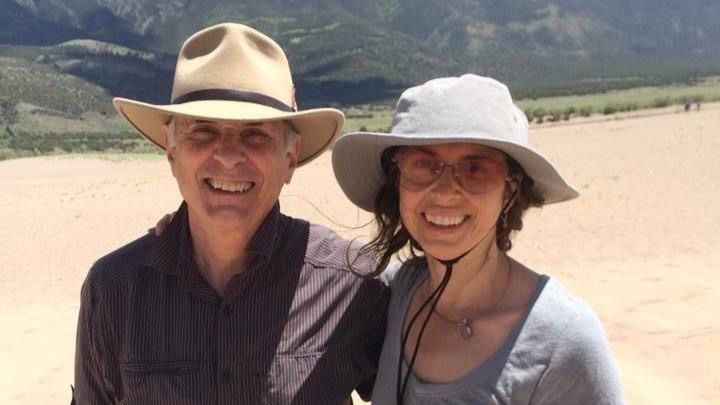
Zapata Ranch writing residency
Donation protected
My name is Nissa Valdez, and I am raising money for a writing residency at Zapata Ranch in the San Luis Valley of southern Colorado. This cattle and bison ranch welcomes visitors to their small guest lodge to experience ranch life at the edge of the Great Sand Dunes National Park. The photo above is of my dad and me the last time we visited the dunes together. This campaign is my attempt at grassroots fundraising. After searching for many months for a grant, fellowship or residency that would allow me to go to this specific place, I was unsuccessful.
The land Zapata Ranch is situated on was the homestead of my great-great-great-grandparents, Teofilo and Andrellita, and my great-great-grandparents, Pedro and Sofia. Two generations of my family were born on this land, including my great-grandmother Estrella Trujillo in 1898. Teofilo and Andrellita were born in northern New Mexico, still part of Mexico when they were born. They migrated north and homesteaded the land in 1865, becoming the first documented settlers.
Their only son who survived into adulthood, Pedro, was my great-great-grandfather, and he homesteaded land adjacent to theirs in 1879. He married my great-great-grandmother, and they raised their family and ranched and farmed on the land. They raised sheep, cattle, and horses and grew grains, vegetables, fruit, and tobacco. They were self-sufficient on this quite desolate land and separated from any other settlement, just on the edge of the dunes.
In 1902, while Teofilo was attending court around an incident wherein white ranchers had slaughtered some of his livestock, the group returned, set fire to one of their houses, and slaughtered ninety of their sheep. They were ultimately driven off the land by these tactics. At that time, they held a 1,500-acre settlement.
Part of the original homestead (32 acres) has been preserved and designated as a National Historic Landmark to mark the settlement story of the southwest US. Another part of the land is still in operation as a ranch. Teofilo and Andrellita’s and Pedro and Sofia’s houses are still there. The Nature Conservancy now owns the land, and they chose it because it provides landscape-scale conservation of a biologically significant area. It is cared for by Ranchlands, a company that operates large-scale cattle and bison ranches with a focus on conservation and ecotourism; one of them is Zapata Ranch.
I have been involved in a poetry apprenticeship through The Loft Literary Center for the last year. With the support of my family, my mentor, the seven poets in my cohort, and the two women in my weekly writing group, I have written a substantial amount of poetry for a collection that I hope to have published in the near future. Three of my poems have been published in literary journals in the last six months, including childhood punctuated. I also share haiku and nature photography on my Instagram page.
Much of my writing focuses on family, legacy, heritage, inheritance, and intentionality about what gets passed down. It involves investigating the intersection of colonizer and colonized and how these cycles of displacing and being displaced seep down through generations. Zapata Ranch is a uniquely appropriate place for me to interrogate some of these themes.
Landscape and place are also integral parts of my writing, so Zapata Ranch is a fitting place for me to work, even beyond my family's connection to it. Because of the conservation efforts and practices that have been in place for many years, ecologically diverse meadows, wetlands, dunes, and cottonwood groves provide a safe habitat for rare insects, plants and animals.
The Ant-like Flower Beetle and Great Sand Dunes Tiger Beetle are found nowhere else on earth. One of the world’s largest populations of rare slender spiderflower can be found here, and the wetlands provide habitat for American Bitterns, White-faced Ibis, and during spring and fall migrations for Sandhill Cranes.
This is a trip of a lifetime for me, to spend time on the land, listening to what it has to tell me. My family once belonged to this land, tending to it and subsisting on the fruits of their labor. I am driven to be there and to record my revelations and reflections through writing and photography. I am grateful that there is this one place on earth where I can be on land that has supported my ancestors and been preserved so that I can experience it much as they experienced it.
Zapata Ranch does not have an artist residency program, but they have generously offered me a discount for my stay there. I have reserved a room for 14 nights starting March 8, 2023. My time there will overlap with the Sandhill Crane migration. I will be able to participate in educational programs, learn about ranching and conservation of the land, ride horses in the dunes, and have undisturbed writing time while being fed gourmet food from the ranch.
If I raise more than my target goal, I will put that money towards paying rent and recurring bills to keep my family and my business afloat. Because the ranch has a group booked for a couple of days, I must leave during that time. I have not added this cost to my total, so it will also help cover the days I will be away from the ranch.
Organizer
Nissa Valdez
Organizer
St. Paul, MN